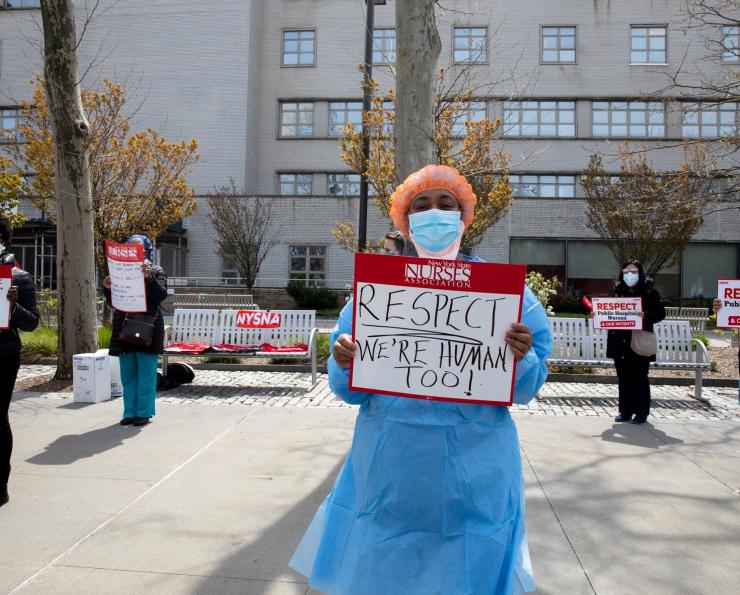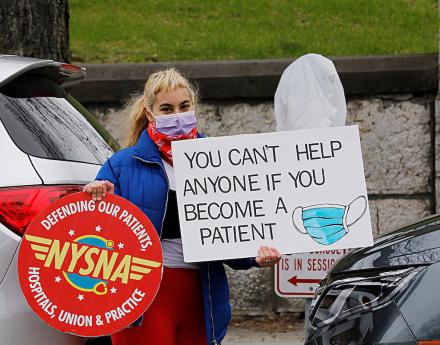Infectious Diseases
Nurses are exposed to numerous infectious diseases in the healthcare setting. NYSNA fights for improvements in infection control practices as well as improvements in pandemic preparedness for the future.

Nurses are exposed to numerous infectious diseases in the healthcare setting. COVID-19, HIV, hepatitis, influenza, tuberculosis, MRSA, MERS and Ebola are just some of contagious agents from which healthcare workers must be protected. New pathogens emerge on a regular basis.
Proper infection control practices protect both patients and healthcare workers. NYSNA fights for improvements in guidelines and regulations related to infectious disease transmission in healthcare environments as well as improvements in pandemic preparedness for the future.
The U.S. Centers for Disease Control and Prevention (CDC) sets infection control guidelines for healthcare facilities. However, this guidance is weak on worker protection and often does not accurately follow current science on disease transmission. CDC guidance for healthcare providers can be found here. The CDC is in the process of updating this guidance. NYSNA, NNU and other unions representing healthcare workers are pressuring the CDC to improve, instead of weaken, this guidance. Background on this campaign can be found here .
OSHA, which is the only federal agency specifically tasked with worker protection, has only one standard related to infection control – the Bloodborne Pathogens Standard. OSHA issued a temporary standard related to COVID-19 in 2021, but this standard has expired. OSHA has stated that a new, permanent infection control standard will be proposed in the near future. However, limited information is available on the content of this standard or the timeline for promulgation and implementation. NYSNA will notify its members with any updates on this possible new standard.
OSHA also has standards related to PPE. See General Requirements, Eye and face protection, and Respiratory protection.
Modes of Transmission
The modes of infectious disease transmission that most affect healthcare providers are:
- Bloodborne
- Contact
- Aerosol (droplet + airborne particulates)
Methods to prevent transmission vary based on the mode of transmission. The CDC, and most healthcare facilities, continue to consider droplet and airborne transmission as two separate modes of transmission. However, scientific evidence has clearly determined that, where a pathogen is spread via droplets, smaller, lighter airborne particulates are also present. These particulates travel farther, stay airborne longer and cannot be stopped by surgical or procedure masks. The World Health Organization (WHO), in recognition of overwhelming scientific evidence, has recently issued new terminology for pathogens that transmit through the air. The report states that:
- Individuals infected with a respiratory pathogen can generate and expel infectious particles containing the pathogen, through their mouth or nose by breathing, talking, singing, spitting, coughing or sneezing. These particles should be described with the term ‘infectious respiratory particles’ or IRPs.
- IRPs exist on a continuous spectrum of sizes, and no single cut off points should be applied to distinguish smaller from larger particles. This facilitates moving away from the dichotomy of previously used terms: ‘aerosols’ (generally smaller particles) and ‘droplets’ (generally larger particles).
The descriptor ‘through the air’ can be used in a general way to characterize an infectious disease where the main mode of transmission involves the pathogen travelling through the air or being suspended in the air.
The CDC has not yet accepted this WHO guidance. Why does this matter? Droplet controls only require a surgical/procedure mask and possibly goggles/face shield for protection. Airborne transmission controls require respirators and specialized ventilation and air filtration. By refusing to accept that pathogens that are transmitted by droplets are also transmitted by airborne particulates, healthcare employers can spend far less money on infection control measures.
NYSNA and other unions will continue to pressure guidance and enforcement agencies to require effective controls to prevent healthcare staff and patient infection.
The following are some of the controls that should be used to limit the transmission of infectious diseases to healthcare providers:
Bloodborne
- Engineered sharps, including “retractable” or self-sheathing needles
- PPE including gloves, gowns and face shields where splashes of bodily fluids are possible
- Needleless systems
- Easily accessible sharps containers
- Regular review of sharps injuries to determine if newer sharps devices or changes in practice can prevent future injuries
- Hepatitis B vaccination
- See the OSHA Bloodborne Pathogens Standard for required workplace protections
Contact
- Thorough cleaning with disinfection products that are effective against the pathogen in question
- Disinfection with UV where appropriate
- PPE such as gloves, gowns and, when necessary, face, foot and head coverings
- Proper training in PPE doffing to prevent contamination
- Adequate number of isolation rooms
Aerosol
- Adequate number of Airborne Infection Isolation Rooms (negative pressure rooms)
- Ability to quickly construct temporary negative pressure rooms
- Improved ventilation via high-level MERV filtration of HVAC systems
- Portable HEPA filter equipment
- Increased percentage of outside air circulating through HVAC system
- Fit-tested respiratory protection (N95, elastomeric respirator, PAPR or CAPR)
- Source (infected patient) and visitor masking
- Ability to quickly identify and isolate patients who are suspected of having the airborne transmissible disease
- Vaccination when possible
The precautionary principle should always be followed when modes of transmission may not be fully understood, such as with novel (new) infectious pathogens. In other words, provide the most protection until it is certain that less protection will not result in possible healthcare employee infection from exposure to a dangerous pathogen, chemical or other hazardous substance.
General Infectious Disease Information
General information regarding infectious disease protection can be found at:
National Institute for Occupational Safety and Heath
CDC Morbidity and Mortality Weekly Report*
Your Local Epidemiologist is a good resource for up-to-date information on current and potential infectious diseases.
NYSNA and NNU Infectious Disease Control and Prevention Resources
Pandemic Preparedness Checklist
Infectious Diseases Update May 2024
Norovirus
Avian Influenza
Avian Influenza (H5N1) Health & Safety Guidelines
Avian Influenza: What Nurses Need to Know
Tuberculosis
Occupational Exposure to Tuberculosis: What Nurses Need to Know
Archived tuberculosis resources
Measles
NNU Measles: What Nurses Need to Know
Mpox (Monkey Pox)
MPox Alert: New Clade I Outbreak Raises Concerns
NYSNA Practice Alert: Monkey Pox
Legionnaires' Disease
Understanding Legionnaires' Disease: What You Need to Know
Archived legionnaires' disease resources
Ebola
NYSNA Healthcare Worker Safety Guidelines for Suspected Ebola Patients
Zika
MERS
NYSNA Practice Alert: What Nurses Need to Know about MERS-COV

